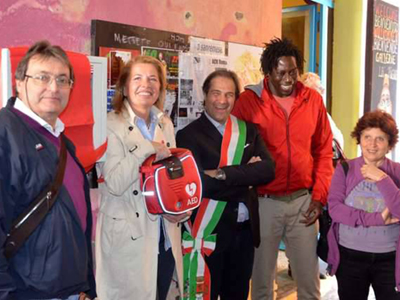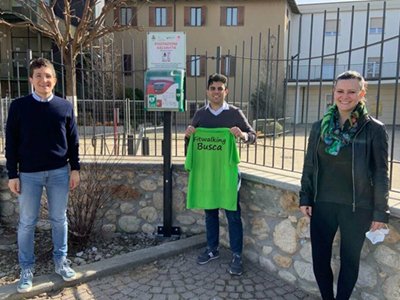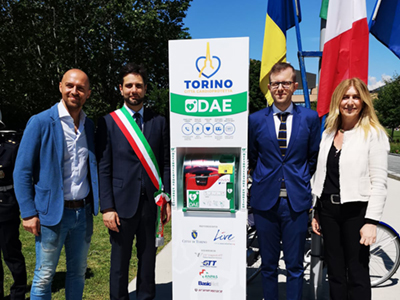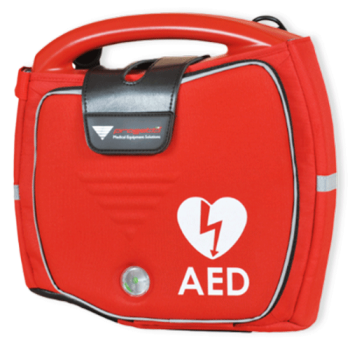Essential features
LEARN MORE
The AED must automatically detect as many defibrillable arrhythmias as possible (only 4 in the world do this and RESCUE SAM is one of them).

The AED must be intuitive and the commands issued must be clear to best support the rescuer.

The AED must be provided with all the certifications and requirements required for electro-medical devices.

The company must guarantee the product also in the following years with maintenance plans and software updates.
Request a consultation
Need help? Do you have any doubts? We are available to advise you on the product that best meets your needs
The optimal features of the defibrillator
01
PRODUCER HISTORY
A national manufacturer also offers solidity and quality in service; If it is reliable, it guarantees continuity of service, since the defibrillator has an average life of more than 10 years. It is easier to run into problems with unknown devices, without a historicity or an established reputation.
02
CERTIFICATIONS
Very important are the certifications, the AED must have obtained the EEC Mark, compliance with IEC 60601 and IEC 60601 1-2-4 safety standards and the manufacturer/distributor must be ISO certified.
03
QUALITY vs PRICE
Buying a low-cost AED means buying a life-saving device with dubious quality that has no guarantees or support during after-sales. In addition, the initial savings involve extra costs for spare parts and maintenance over the life of the AED; so the time will take away the convenience.
04
FOR ADULTS AND PEDIATRIC
The advanced, best and above all most useful defibrillators are those that have a possibility of combined use for adults and children. There are proposals on the market with only adult configurations or only pediatric configurations, which should be chosen only in specific situations.
05
PROTECTION INDEX
We advise you not to buy defibrillators whose Protection Index is unknown or of which only a part is known, as you will not be able to be sure of their effective level of protection against dust and liquids.
06
TECHNOLOGY USED
The biphasic wave allows the defibrillator to handle greater impedance ranges, offering the best existing performances: the best life-saving therapy with fewer side effects for heart cells. The algorithms also allow continuous analysis even during the charge of the shock.
07
DIMENSIONS AND WEIGHT
A compact and lightweight AED can be easily transported in an emergency.
08
EASE OF USE
The AED should be intuitive, easy to use, with clear voices and images that can guide you in case of use.
09
MAINTENANCE AND MANAGEMENT
Batteries, electrodes and software must be periodically updated and the annual cost may vary; Excessively cheap AEDs end up with problems soon. In addition, the initial savings result in the end in spare parts with a shorter life. The initial convenience is thus lost with the passage of time.
10
SUPPORT AND TESTING
Does the AED have a periodic self-test system? Does it have a software? Can the defibrillator be maintained without problems for a long time? The device may need to be updated, manually or independently via USB cable and manufacturer’s software.
Further tips
CONTROLS TO KEEP IN MIND
The only necessary controls are:
· Replace any used, damaged or expired accessories
· Check that the outside and case of the defibrillator are not damaged
· Check that the indicator that marks that the defibrillator is working properly
Some defibrillators perform an automatic test to verify the device and keep it ready for use: this procedure optimizes the periodic checks performed in person. In case of malfunction, the device signals a lack of readiness. It is increasingly common to activate remote control services for defibrillators, which allow you to check deadlines, operating status, position and use.
BATTERY CONSIDERATIONS
It is good to know that each defibrillator has characteristics that must be preserved over the years.
The AED is in fact powered by a long-lasting non-rechargeable battery, which can be guaranteed by the manufacturer between 4 and 7 years. Currently the most reliable ones on the market have an average life of 5 years, but their operation can be compromised by an accidental drop or improper storage conditions. However, each medical device has a series of alarms in case of malfunction: when these occur, the machine promptly signals the problem.
DEFIBRILLATOR ELECTRODES
Together with the battery, there are electrodes, or the “pads” that are applied to the chest of the person to deliver the shock. The electrodes have an expiration date and must be replaced after each use, or after 24 months.
UPDATE YOUR AED
The AED may have updates in case of changes to the Guidelines on the use of defibrillators. Depending on the company or retailer, the upgrade may be offered by a technician. A defibrillator is not a device to be forgotten in a corner; the device must remain visible so that its status can be checked.
ATTENTION TO PRICES
Beware of the possible deception of a low price of consumables and consider their durability. Low-quality consumables may be compatible but result in shorter lifespan. In a worst-case scenario, they may not work properly at the time of use. A factor to consider is that, according to the regulations on medical devices, if the compatible component is not reported and authorized by the manufacturer, this affects the warranty of the device.
Protection for who protects you
Nel caso in cui si decida di posizionare il defibrillatore all’aperto ci si deve munire di una teca in cui posizionare il proprio DAE. I defibrillatori infatti sono apparecchi elettrici che potrebbe non funzionare correttamente se esposti a temperature sotto lo 0° o sopra i 50°. Se la destinazione del defibrillatore è all’esterno è necessario proteggere il DAE con una teca dotata di termostato per regolare la temperatura che, oltre dall’acqua e dalla polvere, lo protegge dagli sbalzi termici. Inoltre se si temono atti di vandalismo o furti si può usufruire di teche dotate di sportello allarmato, il quale suonerà nel momento in cui viene aperto.
Spesso i comuni posizionano il defibrillatore all’esterno di farmacie, uffici, nei pressi di monumenti, piazze o parchi. Le società sportive invece possono posizionare il DAE nei pressi del campo di allenamento, vicino a una piscina oppure sotto una tettoia. Le associazioni di soccorso si trovano spesso a soccorrere in diverse condizioni meteorologiche e di campo; gli stabilimenti
balneari invece usano e posizionano il defibrillatore nelle immediate vicinanze della spiaggia e del bagnasciuga.
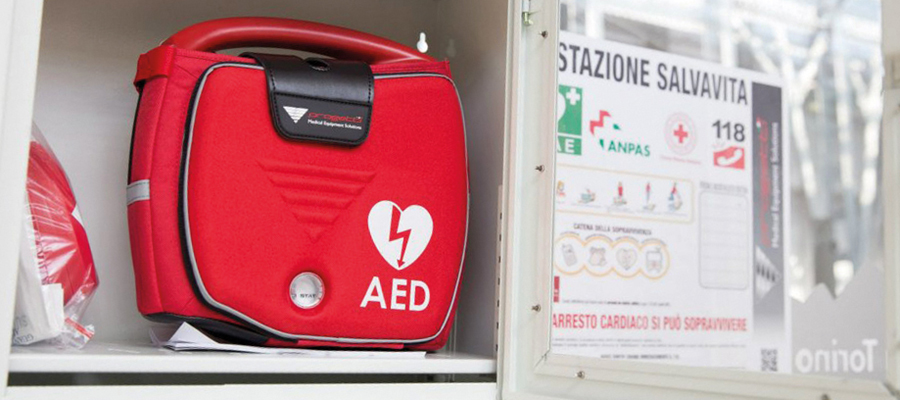
Indice di Protezione dalla POLVERE
- Nessuna protezione
- Protezione contro oggetti solidi più grandi di 50mm
- Protezione contro oggetti solidi più grandi di 12,5mm
- Protezione contro oggetti solidi più grandi di 2,5mm
- Protezione contro oggetti solidi più grandi di 1mm
- Protezione parziale contro la polvere
- Protezione totale contro la polvere
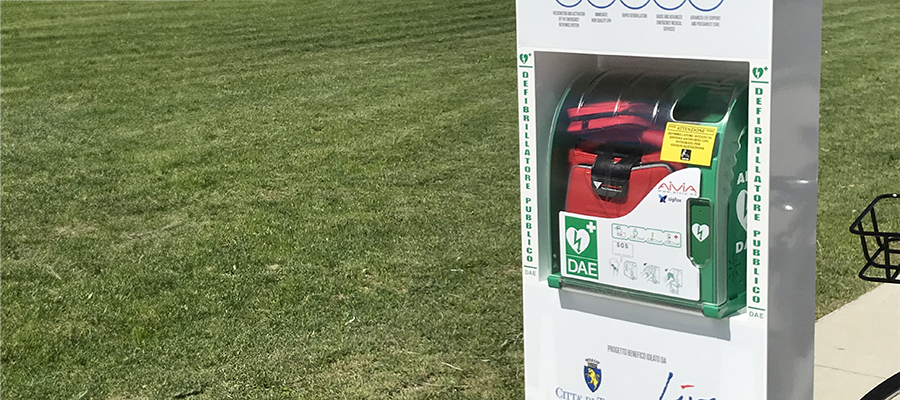
Indice di Protezione dall’ACQUA
- Nessuna protezione
- Protezione contro il gocciolamento
- Protezione contro gli schizzi fino a 15°
- Protezione contro gli schizzi fino a 60°
- Protezione contro gli schizzi da tutte le direzioni - l’ingresso limitato
- Protezione contro gli schizzi d’acqua provenienti da tutte le direzioni - l’ingresso consentito senza compromettere funzioni/sicurezza (es. piscina)
- Protezione contro gli schizzi d’acqua ad alta pressione, da tutte le direzioni (ponte dela nave)
- Protezione contro l’immersione temporanea in acqua tra i 15cm ed 1m.
- Protezione contro l’immersione per lunghi periodi e a grandi pressioni
Città cardio protette
grazie al DAE
PREVENZIONE
Circa un terzo degli arresti cardiaci si verifica nei luoghi pubblici e spesso avere un DAE nelle vicinanze è un elemento cruciale per intervenire entro dieci minuti dall’accaduto. Il Comune è un’istituzione che può farsi promotrice di un progetto di defibrillazione precoce sul territorio, anche in cooperazione con le realtà locali (associazioni, enti pubblici e privati...) per rendere i suoi cittadini veramente cardioprotetti.
